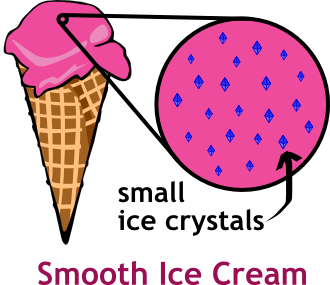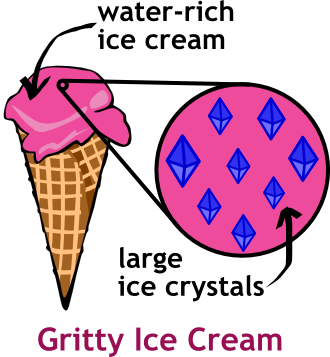
To me, one of the most interesting aspects of nanotechnology is how close in size the nanoparticles we can make are to the nano-sized components of living organisms. These nano sized proteins, lipids and nucleic acids have evolved to form the network of biological machines to support the abundance of life on this planet. Just as we have only begun to understand how to engineer and control synthetic nanotechnology, we are similarly limited in our knowledge of nature’s nanomachines. While some biological nanotechnology has been used by inventive humans for centuries to brew beer or bake bread, we are just beginning to discover some of the potential applications of these complex and fascinating tools. As the weather here has turned warmer (well, sort of…), the thoughts of this scientist have turned to how one of these newly discovered biological nanomachines can change that most refreshing of summer treat: ice cream.
Being as this is Wisconsin and how we love all things bovine, there is, of course, an ice cream factory and store right here on campus. Let me tell you, nothing soothes the pang of a failed experiment or the stress of ambiguous results quite like a cone full of freshly made ice cream. While I would argue that such easy access to ice cream is a great boon to the scientific process, my cardiologist and tailor might not appreciate its benefit to my health and waistline.
In one of the very first posts on this blog, Lee did a great job describing one of the most important properties of a great ice cream experience: the silky smooth, luscious texture of the ice cream as its flavor explodes in your mouth. Lee also talked about what can turn a bowl of ice cream into a gritty mess: big ice crystals. Minimizing the size of the ice crystals is one of the primary goals of any ice cream manufacturer.

So how do they do that? Well, there are many strategies, but the most common way is to decrease the actual amount of water in the ice cream. Think about it this way, the fewer water molecules that touch each other, the smaller the ice crystals will be when the mixture is frozen.

So if we take a bunch of water molecules out of our ice cream mix, what do we put in their place? The answer for hundreds of years has been easy: fat and sugar. Fat and sugar molecules essentially get in the way of ice crystal formation, preventing them from growing into the “gritty” size. In addition to their effect on the formation of ice, both fat and sugar molecules increase the creamy mouth feel of a great ice cream.

But all of this added fat and sugar come at a caloric cost. Take a look at the nutritional information for any “super-premium” ice cream and you’ll see what I mean. As we have become more and more conscious of the health effects of the eating too much ice cream, food scientists have been struggling to come up with an effective way of controlling ice crystal size without increasing the caloric content of ice cream. Part of the answer might come from a very unlikely source: a unique species of fish that lives under the ice of the Southern Ocean.

What makes these Antarctic icefish unique is just how extreme their natural environment is. Some of them live in salt water that averages -2°C (28°F). To survive at these temperatures, the fish need a way to stop damaging and fatal ice crystals forming in their blood and tissues. To accomplish this, the fish secrete a tiny (3 – 6 nanometer) protein that recognizes and binds to any ice in their bodies. Once it grabs ahold to an ice crystal, the protein blocks crystal growth, effectively preventing any ice from getting too large to harm the fish.

So what does that have to do with producing deliciously smooth, low fat ice cream? Well, some very creative scientists figured out that if they add just a tiny amount of this protein to some ice cream, the ice crystals wouldn’t be as large. Thus, they wouldn’t have to add as much fat and sugar to get the same silky texture.
While most of the materials traditionally thought of as nanomaterials are made by chemists in flasks (or giant factory reactors), I think we shouldn’t discount the nanomaterials made by organisms in the environment. I use the word nanomachines to describe them, because these little things are capable of performing tasks that would make any flask-bearing chemists drool with jealousy. These proteins are integral to every known form of life; this ice cream protein is just one example of many where humans have brought these machines out of the cell and into the factory. As we begin to understand more and more about what these machines can do we will almost certainly see an explosion in products and methods that use them directly (like the ice cream) or indirectly (like DNA profiling). Such products will almost certainly change the way we experience the world in the coming years.
